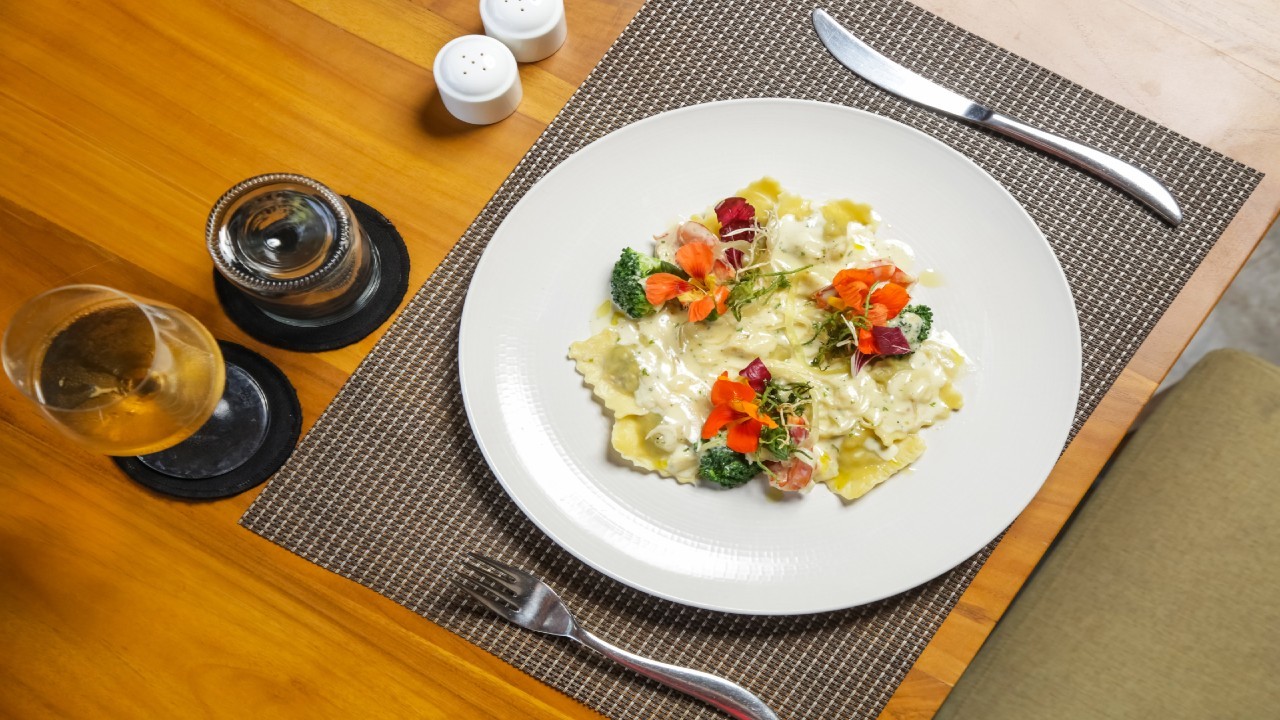

Thu, 25 July 2024

Ingredients:
200g 00 pasta flour (or use strong white flour)
2 large eggs
A selection of edible flower petals and leaves – to include nasturtiums, borage,
calendula, mint, dill, French marigold petals, violas etc.
Salt
40g butter
12 sage leaves
Black pepper
20g Parmesan
Method:
Weigh the flour into a large bowl. Make a well in the middle of the flour and crack in
the eggs. Using a fork gently mix the flour into the eggs, continuing until all the flour
is mixed into the egg. Then use your hands to bring the mixture together into a
dough. It might seem a bit dry at first but it will come together as you knead it.
Turn the dough out onto a clean work surface and knead for five minutes until
the dough is smooth and has a silky surface. If it still seems dry after five minutes add a couple of drops of water and knead them into the dough. Put the dough into an
airtight box or wrap in clingfilm and leave to rest for at least 30 minutes or up to two
hours.
After resting, cut the dough in half, lightly dust with flour and roll it through the widest
setting on the pasta machine. Fold the dough like a letter and then pass it through
the widest setting on the pasta machine again. Repeat the fold and roll through one
more time.
Narrow the setting on the pasta machine by one and roll the pasta through again,
keep rolling and narrowing the setting until the pasta is one setting thinner than you
want it to be. I roll mine to the 6 th setting on my pasta machine. If the sheets get too
unwieldy to manage you can cut them in half. Dust your work surface with flour to
stop the pasta sheets sticking
When you have the pasta rolled as thin as you need it, fold it in half horizontally and
mark the fold and then cut along that line. You should now have two pasta sheets
approximately the same size. On one sheet arrange the edible flowers and leaves in
a pattern. Then place the second sheet on top (ideally use the side that doesn’t have
much flour on it) and press down gently so the two sheets are stuck together with
petals and leaves in the middle. You can use a rolling pin to lightly roll over the top
and stick everything together.
Set the pasta machine to one wider than the last setting you rolled the pasta through
(this is 5 on my pasta machine) and roll the sheet of pasta with petals through again.
Hand cut the pasta into 2-3 cm width strips (like pappardelle). I use a pizza cutter but
you can fold the pasta a couple of times (dusting with flour in between) and use a
sharp knife. Put the cut pasta onto a tray dusted liberally with semolina or you can
hang them over pole or a clean clothes airer works well if you are worried about
them sticking together.
Repeat with any remaining pasta sheets, if you cut the pasta earlier because it was getting too long. Then repeat with the second piece of dough.
Put a large pan of water on the hob over a high heat. While you are waiting for the
water to boil, put a wide pan on the stove over a medium-high heat. Once, hot add the
butter and cook for a couple of minutes until you start to see brown specks in the
butter, immediately toss in the sage leaves and cook for another 30 seconds until the
Sage is crispy. Turn off the heat.
Once the pasta water is boiling, salt the water generously, I use about 3 teaspoons.
Add the pasta and cook for one minute. Drain the pasta in a colander and then add
the well-drained pasta to the sage butter. Toss the pasta in the butter and season
generously with black pepper. Put the pasta in warm bowls grate the parmesan over
the top and sprinkle over any remaining edible flowers.
Mon, 14 July 2025
Chef: Lara Battigelli
View More.